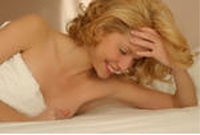|
The aging process has you firmly in its grasp if you never get the urge to throw a snowball. Doug Larson |
Prescription for aging beautifully
Mammalian skin often contains hairs, which in sufficient density is called fur. The hair mainly serves to augment the insulation the skin provides, but can also serve as a secondary sexual characteristic or as camouflage. On some animals the skin is very hard and thick, and can be processed to create leather. Reptiles and fish have hard protective scales on their skin for protection, and birds have hard feathers, all made of tough β-keratins. Amphibian skin is not a strong barrier to passage of chemicals. A frog sitting in an anesthetic solution will quickly go to sleep. The skin is often known as "the largest organ in the human body". This applies to exterior surface, as it covers the body, appearing to have the largest surface area of all the organs. Moreover, it applies to weight, as it weighs more than any single internal organ, accounting for about 15 percent of body weight. For the average adult human, the skin has a surface area of between 1.5-2.0 square metres, most of it is between 2-3 mm thick. The average square inch of skin holds 650 sweat glands, 20 blood vessels, 1000 melanocytes, and more than a thousand nerve endings. The outermost epidermis is consists of stratified squamous epithelium with an underlying basement membrane. It contains no blood vessels, and is nourished by diffusion from the dermis. The main type of cells which make up the epidermis are keratinocytes, with melanocytes and Langerhans cells also present. The epidermis can be further subdivided into the following strata (beginning with the outermost layer): corneum, lucidum, granulosum, spinosum, basale. Cells are formed through mitosis at the innermost layers. They move up the strata changing shape and composition as they differentiate, inducing expression of new types of keratin genes. They eventually reach the corneum and become sloughed off (desquamation). This process is called keratinization and takes place within about 30 days. This layer of skin is responsible for keeping water in the body and keeping other harmful chemicals and pathogens out. Blood capillaries are found beneath the epidermis, and are linked to an arteriole and a venule. Arterial shunt vessels may bypass the network in ears, the nose and fingertips. The hypodermis is not part of the skin, and lies below the dermis. Its purpose is to attach the skin to underlying bone and muscle as well as supplying it with blood vessels and nerves. It consists of loose connective tissue and elastin. The main cell types are fibroblasts, macrophages and adipocytes (the hypodermis contains 50% of body fat). Fat serves as padding and insulation for the body. Skin can be dividided into thick and thin types. Thick skin is present on the soles of the feet and the palms of the hands. It has a larger stratum corneum with a higher keratin content. Thick skin does not grow hair; its purpose is to help grip. Thin skin is present on the bulk of the body and has a smaller stratum corneum and fewer papillae ridges. It has hair and is softer and more elastic. The characteristics of the skin, including sensory nerve density and the type of hair, vary with location on the body. Functions of the skin are disturbed when it is dirty and it becomes more easily damaged. The release of antibacterial compounds decreases. Dirty skin is more prone to develop infections. Cosmetics should be used carefully because these may cause allergic reactions. Each season requires suitable clothing in order to facilitate the evaporation of the sweat. Sunlight, water and air play an important role in keeping the skin healthy. The skin supports its own ecosystems of microorganisms, including yeasts and bacteria, which cannot be removed by any amount of cleaning. In general these organisms keep one another in check and are part of a healthy skin. When the balance is disturbed, e.g., by antibiotics which kill bacteria, there may be an overgrowth and infection by yeasts. The skin is continuous with the inner epithelial lining of the body at the orifices, each of which supports its own complement of flora. You are never too young or too old to start taking care of your skin. In fact, skin care and protection should be an essential part of your health, fitness, and beauty regime. If you take care of your skin, your skin will take care of you! But with all of the lotions, creams, and potions on the market, it can be difficult to know which product will work for you. Many products claim to remove wrinkles or heal dry skin. Others claim to contain expensive ingredients that they say will improve the effects of the product. When you do use soap, try using a natural very mild soap that does not contain any dyes, parabens or perfumes. Follow up the bath with a moisturizing lotion, concentrating on problem dry areas. A good all natural moisturizer is one of the foundations for a healthy skin care regimen. Continue moisturizing throughout the day to keep skin healthy. Your hands and face are particularly susceptible to daily damage, and may need to be moisturized several times. Wash your skin thoroughly on a daily basis to remove the dirt, debris, pollutants, and perspiration that accumulates on a daily basis. If you have dry or sensitive skin, use only warm water to wash your skin and use a mild natural cleanser every few days. If you have normal or oily skin, be sure to wash with a gentle cleanser on a daily basis. Be sure to brush your teeth before washing your face, as toothpaste residue can irritate sensitive facial skin. Unless your skin is very oily, you will want to use a moisturizer everyday to keep your skin hydrated and healthy. Your skin needs moisturizer all year long as both the indoor winter heat, and summer sun can be equally damaging to your skin. Acne, pimples, sunspots, age spots, wrinkles and other blemishes are skin conditions that plague people the world over. The global beauty industry already makes billions of dollars every year as women everywhere embark on quests to preserve (or achieve) a youthful, glowing appearance. Responding to this need, dermatologists, and other specialists continue to look for the best and safest possible treatments and formulations to combat skin ailments, the most common of which is acne. Apart from the services offered at skin clinics, many creams, gels and ointments that claim to treat acne, diminish sun or age spots and enhance skin elasticity are widely available in the market. There are scrubs, cleansers, masks, over-the-counter skin medicine and skin peel formulations, all offered at various price ranges. Most can be bought at department stores or drugstores, but the fact is that very few of these so- called miracle products actually work. Why is it that practically everyone in the middle class to the upper levels of demographics in any country are worried about getting wrinkles? Maybe it is the fear of getting old or looking old, or the wanting to look socially acceptable, or just plain vanity. We all have our own reasons. But whatever it is, everyone is united in wanting to solve this age old problem. However, in the first place, do we even have any idea about what actually causes these dreaded wrinkles? It's highly probable that we don't. The most important factor in finding a solution to any problem is finding out the root cause of it. As we age, our body undergoes various changes, and so does our skin. In our skin, we have tissues known as collagen and elastin. These tissues are mainly responsible for making our skin firm and stretchable. As we grow older, the amount of collagen and elastin in our skin naturally diminishes. As a result, our skin becomes less elastic and weaker, thus creating "wrinkles". One less painful procedure is the particle skin resurfacing procedure. The process is removes the outer layer of skin in a highly controlled manner. Because of its preciseness, it is practically painless. By repeating this procedure a number of times, the younger skin moves to the surface, thus promoting visible changes in the skin's texture, color and appearance. The benefits of this skin resurfacing procedure are that it causes very little pain or discomfort, no recuperative period is needed, there is minimal risk, it can be used for all skin types, and no anesthesia is required. The important thing to remember when seeking out treatment for your wrinkles is to know first how your body can possibly react to the treatment. Get in touch with a skin doctor for things that you are not sure of, but are contemplating on trying out. While it is true that physical beauty is just skin deep, it is still no reason why people, particularly women, should disregard basic skin care. Since the skin is our outermost layer, it is exposed to the harsh elements of the environment. And because it is not uncommon for people to base judgments from our cover, with the face being the first thing they look at, it is only proper that we go to great lengths to keep our skin looking clean and fresh.
Terms on this pageEpidermis Hypodermis Pimples Ultraviolet radiation Keep in touch. Latest healthcare tips from professionals.
|

